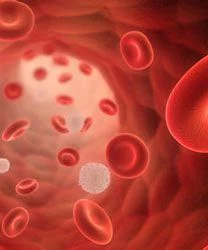Article
Ruxolitinib Delivered at Maximum Dose Peri-Transplant Proves Safe in Myelofibrosis
Author(s):
February 10, 2021 - The JAK 1/2 inhibitor ruxolitinib, when given at a maximum dose of 10 mg peri-transplant, has been shown to be safe and feasible in patients with myelofibrosis.

The JAK 1/2 inhibitor ruxolitinib (Jakafi), when given at a maximum dose of 10 mg peri-transplant, has been shown to be safe and feasible in patients with myelofibrosis, according to results from a pilot study presented during the 2021 Transplantation and Cellular Therapy Meetings.1
The prospective pilot trial (NCT02917096) looked at the use of ruxolitinib during allogeneic hematopoietic cell transplantation (HCT) in order to identify the maximum tolerated dose (MTD) of ruxolitinib along with its safety profile. Allogeneic HCT is currently the only potentially curative therapy for patients with MF, but researchers believe that by adding ruxolitinib during HCT, outcomes will improve.
Ruxolitinib was given to 18 patients at 2 dose levels (DL) of 5 mg (n = 6) and 10 mg (n = 12) twice daily for up to 100 days, starting 3 days prior to transplant. Patients also received conditioning therapy for HCT of fludarabine and melphalan plus graft-versus-host disease (GVHD) prophylaxis of tacrolimus and sirolimus.
All 18 patients achieved engraftment with neutrophil recovery, patients in the 5-mg arm achieved engraftment within 19 days (range, 13-23) and patients in the 10-mg arm achieved engraftment within 16 days (range 12-22); however, at each DL, 1 patient developed a dose-limiting toxicity (DLT). In the 5-mg arm there was 1 grade 3 cardiac and gastrointestinal DLT and 1 grade 4 pulmonary DLT, while in the 10-mg arm 1 patient experienced grade 3 kidney damage.
Cumulative incidence (CI) of acute GVHD, grades 2-4, was 17% (95% CI, 6%-47%) in the 5-mg arm and 11% (95%, 3%-41%) in the 10-mg arm. Overall, CI of chronic GVHD was found to be 42% (95% CI, 24%-74%) at the 1-year mark. At a median follow-up of 22.6 months (range, 6.2-25.8), among surviving patients, the 1-year overall survival (OS) rate was 77% (95% CI, 50%-91%) with a progression-free survival rate of 71% (95% CI, 44%-87%). Six percent of patients relapsed (95% CI, 1%-40%) while the rate of non-relapse mortality was 23% (95% CI, 10%-54%). Four patients died over the course of the study; causes of death included cardiac arrest, GVHD, respiratory failure, and refractory GVHD of the patient’s liver.
Median age of patients with myelofibrosis at the time of HCT was 65 years (range, 25-73) for the overall study. In the 5-mg arm, the median age was 53 (range, 25-66) and in the 10-mg arm was 69 (range, 55-73). Four of the patients on the trial were considered high risk with 14 at intermediate risk. The time from diagnosis to initial treatment with HCT was 17 months in the 5-mg arm and 17.2 months in the 10-mg arm. Five patients received graft sources from matched siblings while 13 received them from an unrelated donor. Driver mutations of JAK2 were identified in 9 patients, MPL in 1, CALR in 4, and 4 patients were triple negative.
In the 5-mg arm, it took a median of 20 days (range, 19-35) before developing acute GHVD while in the 10-mg arm it took a median of 45 days (range, 18-93). Six patients had maximum acute GHVD on ruxolitinib of grade 1, grade 2 in 1 patient, and grade 3 in 2 patients across DLs. However, the time to development of chronic GHVD was longer in the 5-mg arm at 324 days (range, 195-370) compared to the 10-mg arm that developed chronic GHVD by 198 days (range, 123-232). Maximum chronic GVHD was reached by 5 patients in the 5-mg arm compared to 4 in the 10-mg arm. Two patients died prior to the 100-day post-transplant assessment.
A pharmacokinetics analysis of ruxolitinib showed that after doubling the dose, there was a greater level of AUC of 0 to infinity of 546.2 nM/hour compared with 990.6 nm/hour, as well as an increase in Cmax levels at 150.8 nM in the 5-mg arm and 273.4 nM at the 10-mg arm. Based off these results, the researchers concluded that the 10-mg dose of ruxolitinib was the MTD to use for patients with myelofibrosis being treated peri-HCT.
Reference
- Ali H, Tsia N, Mokhtari S, et al. Peri-Transplant Administration of Ruxolitinib (Rux) in Patients with Myelofibrosis (MF) Is Safe and Effective. Presented at: 2021 Transplantation and Cellular Therapy Meetings; February 8-12, 2021; virtual. Abstract 169. https://tct.confex.com/tct/2021/meetingapp.cgi/Paper/17488









